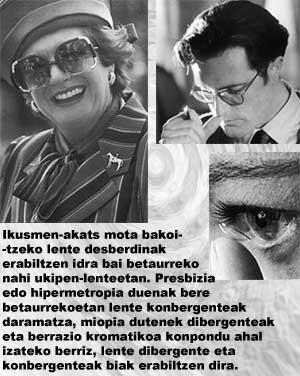Lenses
It may happen that the Roman emperor Nero used the lenses for the first time, even if he does not discover it. To see well the games held in the sands of the circus, the emperor used a faeces emerald. Using a green gem is an indicator of its poor visibility.
The Arabs were the first to worry about visual problems. A study on optics was conducted in the 10th century and visual problems were also analyzed. In the deserts of the Arabs, eye conditions are very numerous and so much attention may be paid to sight and optics.

Ibn Al-Haytham is the most well-known Islamic in the field of optics. Around 1040 he worked in Egypt and wrote a treatise on optics. In addition to the anatomy of the eye, he studied how mirrors and lenses changed the direction of light. It had a small testing factory to polish the glass with lathe and wheels. Arab research was known in his home country and in Europe. However, the inadequacy of the lenses and the high cost of the process, the use of glasses or lenses XIII. It was postponed until the nineteenth century. Once theory and practice were well united, the invention that would benefit many was gradually extended in Europe. It is known that around 1287 in Italy converged lenses were used for shows.
At present the emerald of Nero is not used to read the book or see the horse race. The material has changed a lot, but it remains the goal. The current lens is disc shaped and is made of glass or other transparent material. The lenses have both surfaces or a curve. Here's how lenses work when we see an object.
We receive the rays of light that are reflected in the object we have seen and come through the eyes. The lens of the eye should properly direct these light rays so that we can clearly see the object. When the lenses do not function properly, that is, if the reflected light rays are diverted, nearby and distant objects will not look correctly. In order to redirect light rays, the solution is to place an additional lens on the eye (contact lenses in the glasses or in the eye itself). This lens will correct the visual problem.

In general two types of lenses are distinguished: divergent and convergent lenses. The divergent lens in the center is narrower than at the ends and removes the parallel rays reflected by the object. The convergent lens, on the contrary, is thicker at the center than at the ends and approaches each other as the parallel rays come looking.
Both types of lenses are used in optical instruments such as telescopes, microscopes, cameras and binoculars. In these devices the lenses are different. Microscope lenses make small images look larger. The most prismatic, on the other hand, help to see the far closer. But in our daily life these lenses are used in glasses and contact lenses. For each type of visual failure different lenses are used in both glasses and contact lenses. Those who have presbyopia or farsightedness wear converging lenses in their glasses. Presbyopia is the decreased ability to see closely for the sclerosis of the lens.
These are usually people over the age of 40. Hyperopia is a refractive error of the eye: light rays parallel to the axis of the eye, instead of forming the focus on the retina, produce it behind the retina. This error prevents hypermetropes from clearly seeing objects near the eye. Divergent lenses, that is, those that separate parallel rays from each other, are used by the miopes. People with myopia have difficulty seeing clearly what is far from their eyes. Chromatic aberration is solved with divergent and converging lenses. Lenses are also used to protect certain harmful radiation in professions such as radiologists, welders and pilots.
In addition to glasses and for comfort, contact lenses are currently predominating. These lenses are thin, curved and can be made of glass or plastic. The contact lens is supported and held over the cornea. Like glasses, their goal is to correct visual defects, especially astigmatism and high myopia. However, more and more are used for aesthetic purposes and contact lenses with colors are used to change the natural color of the iris.
Buletina
Bidali zure helbide elektronikoa eta jaso asteroko buletina zure sarrera-ontzian











